
To create a new individual constituent:
1. From
the Personify main menu, select CRM/Orders > CRM360
> Create
New Constituent.
The New Constituent Creation screen displays.
2. Select the Individual
radio button, as highlighted below.

3. The Constituent ID is generated automatically, but can be changed if desired.
4. Select the Constituent Class.
By default, Individual is selected. The values in this drop-down menu are
populated based on the non-fixed CUSTOMER_CLASS
system type for the CUS subsystem.
5. Select the constituent's
Address Type.
By default, Home is selected. The values in this drop-down menu are populated
based on the non-fixed ADDRESS_TYPE
system type for the CUS subsystem.
6. If necessary,
select the constituent's Prefix.
For example, Miss, Mrs., Mr., and etc. The values in this drop-down menu
are populated based on the non-fixed code NAME_PREFIX
system type for the CUS subsystem.
7. Enter the constituent's First Name, if necessary.
8. Enter the constituent's Middle Name, if necessary.
9. Enter the constituent's
Last Name.
This is a required field.
 If
the WEB_PASSWORD_GENERATION
application parameter is set to "LASTNAME" and the constituent's
last name has fewer characters than the value defined for the "PasswordStrengthRegularExpression"
key in the Web.config file, the system will display the following error
when the constituent is saved: "Web Credentials for the user
will not be created as no email id exists."
If
the WEB_PASSWORD_GENERATION
application parameter is set to "LASTNAME" and the constituent's
last name has fewer characters than the value defined for the "PasswordStrengthRegularExpression"
key in the Web.config file, the system will display the following error
when the constituent is saved: "Web Credentials for the user
will not be created as no email id exists."
By default, the value is set to "6" in the code below the Web.config
file:
<!-- Email Verification Settings -->
<!-- Password Regular Expressions Samples
Minimum Length 6:
^.*(?=.{6,})
minimum length 6, one number, one char
^.*(?=.{6})(?=.*\d)(?=.*[a-z]).*$
minimum length 6, one number, one lower case character, one upper case
character, one special character.
^.*(?=.{6,})(?=.*\d)(?=.*[a-z])(?=.*[A-Z])(?=.*[@#$%^&+=]).*$
^.*(?=.{6,})(?=.*\d)(?=.*[a-z])(?=.*[A-Z])(?=.*[@#$%^&+=]).*$
 The
Special Character set can be increased to include !~ etc. Make sure if
using special characters you always have the $ symbol, else it might affect
auto password generation logic.
The
Special Character set can be increased to include !~ etc. Make sure if
using special characters you always have the $ symbol, else it might affect
auto password generation logic.
 The
minimum password length cannot be greater than 8-->
The
minimum password length cannot be greater than 8-->
<KeyValue Key="PasswordStrengthRegularExpression" Value="^.*(?=.{6,})"
/>
10. Select the constituent's
Suffix, if necessary.
For example, II, III, JR, and etc. The values in this drop-down menu are
populated based on the non-fixed code NAME_SUFFIX
system type for the CUS subsystem.
11. Click the Credentials
link to open the Credentials Chooser.
From this screen, search for and select any credentials that apply to the
new customer. For example, CPA, MD, PhD, and etc. The values on this screen
are populated based on the non-fixed CREDENTIALS
system type for the CUS subsystem.
12. The Description of any credential(s) you select is displayed as read-only.
13. Enter the constituent's Nickname, if necessary.
14. From the Parent
Constituent section, select the parent constituent by clicking the Constituent ID link and searching
for a parent constituent, if necessary. See image below.

15. If you selected
a parent constituent, select the Create Employee Employer Relationship
checkbox to create an Employment relationship for the new constituent
and parent constituent.
This relationship will be automatically created on the Relationships
screen.
16. If you selected
a parent constituent, Link Constituent to This Parent Constituent's
Address.
If you select this checkbox, the address fields in the Address section
will be automatically populated with the address of the selected parent
constituent.
17. From the Address section, enter the name of the constituent's Employer, if necessary.
18. Enter the constituent's
Job Title, if necessary.
When the job title is provided in back office or e-Business, it will also
be copied to the Primary Job Title of the constituent.
19. Enter a Personal
Line and/or Mail Stop, if necessary.
The personal line and mail stop are extra ways identifying the customer
for mail routing. Depending on the address structure defined by your organization,
these may be used on mailing labels.
20. Enter the constituent's Address Line 1.
 Although
the address fields are required, if you selected the Address Type "BLANK",
the system will allow you to save the new constituent without entering
an address.
Although
the address fields are required, if you selected the Address Type "BLANK",
the system will allow you to save the new constituent without entering
an address.
21. Enter Address Line 2, Address Line 3, and/or Address Line 4, if necessary.
22. Enter the constituent's
Zip Code.
If more than one city exists for the entered zip code, a pop-up will display
from which you can select the appropriate city.
23. If the system found the zip code entered, the City and State fields will be automatically populated. Otherwise, enter the City and click the State link to search for and select the appropriate state.
24. Enter the County, if necessary.
25. Select the Country from the drop-down menu.
![]() When
an address is created for a constituent that owns the address, an entry
is created in the CUS_Address_Details table and the CUS_Address table.
When a linked address is created for a constituent, an entry is created
in the CUS_Address_Details table. You cannot link an address for an individual
once an unlinked address is saved because the CUS_Address table will not
be properly updated.
When
an address is created for a constituent that owns the address, an entry
is created in the CUS_Address_Details table and the CUS_Address table.
When a linked address is created for a constituent, an entry is created
in the CUS_Address_Details table. You cannot link an address for an individual
once an unlinked address is saved because the CUS_Address table will not
be properly updated.
26. If the new constituent's
information should be published in any base directory reports, whether
printed or published on the Web (e.g., XBT1202), select the Publish
in Directory checkbox.
When unchecked, the e-Business Member Directory web part excludes this
new customer information.
27. Enter the priority in which the address will be listed in the directory in the Directory Priority field.
28. By default, the
Default Bill-to checkbox is checked.
At least one address must be designated as the default bill-to address.
Since this is the constituent's first address in Personify, this checkbox
must be selected. Once the constituent is added to Personify, you can
add
an additional address and designate which of the two is the default
bill-to address on all orders for this constituent.
29. By default the
Default Ship-to checkbox is checked.
At least one address must be designated as the default ship-to address.
Since this is the constituent's first address in Personify, this checkbox
must be selected. Once the constituent is added to Personify, you can
add
an additional address and designate which of the two is the default
ship-to address on all orders for this constituent.
30. If the new constituent does NOT want their address to display on base roster reports (e.g., MBR1212PE), select the Confidential checkbox.
![]() When
defining contact information for a constituent, phone, email, web/social
media, and fax communication methods can be marked as “Include in Directory”.
Additionally, address communication
methods. can be marked as “Confidential”. In the back office, all
online roster and directory reports where the last character in the report
name is “E” (for external), respect the “Confidential” and “Include in
Directory” definition for the listed constituents’ communication methods.
For example, if John Smith has his personal mobile phone number marked
as not to be included in the directory, that number will not be included
in the MBR1200PE report.
When
defining contact information for a constituent, phone, email, web/social
media, and fax communication methods can be marked as “Include in Directory”.
Additionally, address communication
methods. can be marked as “Confidential”. In the back office, all
online roster and directory reports where the last character in the report
name is “E” (for external), respect the “Confidential” and “Include in
Directory” definition for the listed constituents’ communication methods.
For example, if John Smith has his personal mobile phone number marked
as not to be included in the directory, that number will not be included
in the MBR1200PE report.
For
example, MBR1200CE and MBR1200PE. MBR1200CE means it is a report that
lists companies first (hence the “C” in MBR1200CE), then the employees,
and finally, it is an external report (hence the “E” in MBR1200CE).
This
means that its intended audience is people outside the organization. MBR1200PE
means it is a report that lists individuals (hence the “P” for “professionals”
in MBR1200PE), and it
is intended to be viewed by people outside the organization (hence the
“E” for “external” in MBR1200PE).
The confidential flag is ignored on internal reports, which are reports
that have an “I” as the last character in their name (e.g., MBR1200CI and
MBR1200PI).
The “confidential” flag is also respected in the mobile member directory.
31. Click Validate
Address.
The Address Validation screen displays with the status of the validation.
Click Accept. See Validating
a Customer Address for more information.
![]() To
add another address for the company, click Add Additional Address.
See Adding
Additional Customer Addresses for more information.
To
add another address for the company, click Add Additional Address.
See Adding
Additional Customer Addresses for more information.
![]() If you do not want to change the alias, but still want to be able to access
the Customer Central screen when needed, users with privileges to use
the command builder can use the following command: cmd://OpenView?Name=CusCentral&IgnoreAlias=True.
This command will ignore the alias defined to open CRM360 and will open
the Customer Central screen. See Command
Builder Detail for more information.
If you do not want to change the alias, but still want to be able to access
the Customer Central screen when needed, users with privileges to use
the command builder can use the following command: cmd://OpenView?Name=CusCentral&IgnoreAlias=True.
This command will ignore the alias defined to open CRM360 and will open
the Customer Central screen. See Command
Builder Detail for more information.
32. Click Next.
The Contact Info tab displays, as shown below.

33. On the Contact Info tab, enter the contact's information, including Location, Country Code, and Number. The options include:
· Phone
· Mobile
· Fax
 For
more information on the default SSO settings when creating a new constituent,
please see Customer
Creation and SSO.
For
more information on the default SSO settings when creating a new constituent,
please see Customer
Creation and SSO.
· Web
34. Check the Include in Directory checkbox next
to the appropriate contact information, if necessary.
When checked, this indicates the new constituent gives permission to publish
the selected contact information.
35. Check the Do
Not Call checkbox next to the appropriate contact information, if
necessary.
Today’s date is automatically selected as the start date in which the contact
information cannot be called. The contact information cannot be called
for purposes of soliciting or promoting a product, service, membership,
and etc. If this checkbox is selected, "On Do-Not-Call Registry"
will display to the right of the contact method on the Contact
Information screen in CRM360, as highlighted below.

36. In the Additional
Non-Primary Contacts Methods section, select the Type from the
drop-down, fill out the appropriate fields, and click Add.
The fields in this section change depending on the Type selected. You can
also select whether you want to include the contact in the directory.
Once you add the contact, you can select the Do Not Call checkbox in the
table cell.
37. Click Next.
The Special Info tab displays, as shown below.

38. On the Special Info tab, select the appropriate permissions. The options include:
· Allow
Email – When checked, it indicates emailed communications can be sent
to this constituent. When unchecked, no emailed communications can be
sent to this constituent with the exception of automated system notifications.
If this checkbox is unchecked, "Do Not Solicit" will display
in red text to the right of the Email communication method on the Contact Information screen
in CRM360, as shown below.

· Allow
Fax – When checked, it indicates faxed communications can be sent
to this constituent. When unchecked, no faxed communications can be sent
to this customer, regardless of whether the communication is considered
promotional solicitation or not. If this checkbox is unchecked, "Do
Not Solicit" will display in red text to the right of the Fax communication
method on the Contact Information
screen in CRM360, as shown below.

· Allow
Solicitation – When checked, it indicates solicitations can be sent
to this constituent. If this checkbox is unchecked, the "Allow All
Solicitation" checkbox will be unchecked and "Do Not Solicit"
will display in red text to the right of each communication method on
the Contact
Information screen in CRM360, as shown below.
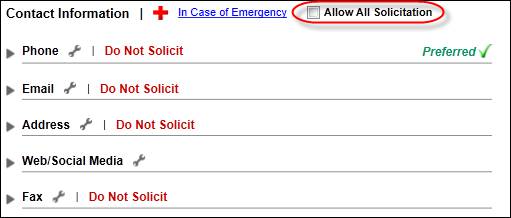
· Allow
Phone – When checked, it indicates the constituent can receive phone
calls. If this checkbox is unchecked, "Do Not Solicit" will
display in red text to the right of the Phone communication method on
the Contact
Information screen in CRM360, as shown below.
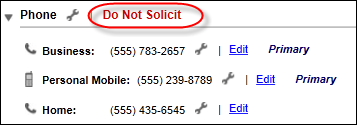
39. From the Billing
Information section, select the appropriate billing information method
either by Bill Direct or Bill Parent Constituent, as shown below.
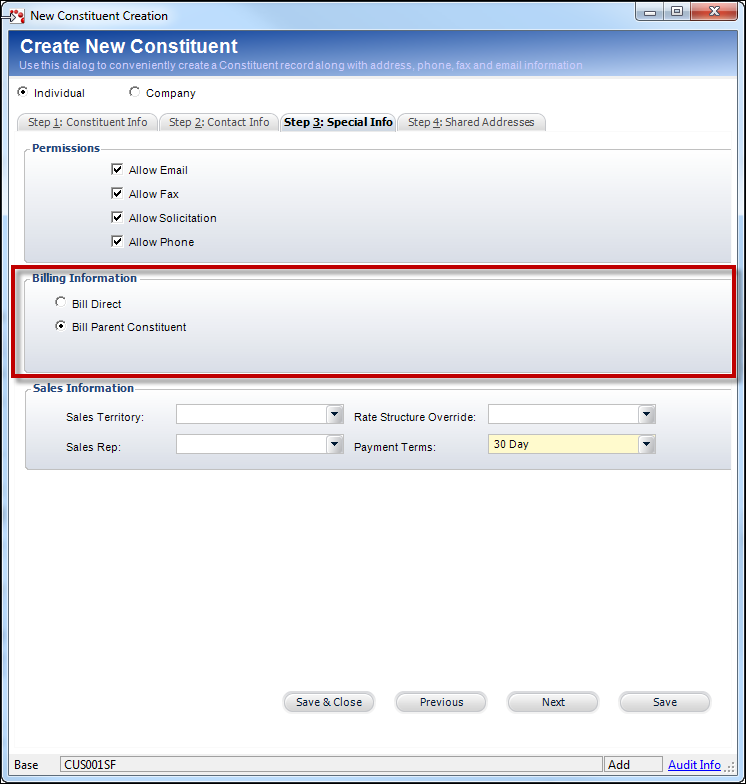
40. From the Sales Information section, select the Sales Territory, Sales Rep, Rate Structure Override, and Payment Terms
41. Click Next.
![]() You
must save the constituent before proceeding to the next tab. If you have
not yet validated the address, the Address Validation screen displays.
See Validating
a Customer Address for more information.
You
must save the constituent before proceeding to the next tab. If you have
not yet validated the address, the Address Validation screen displays.
See Validating
a Customer Address for more information.
The Shared
Addresses tab displays, as shown below.
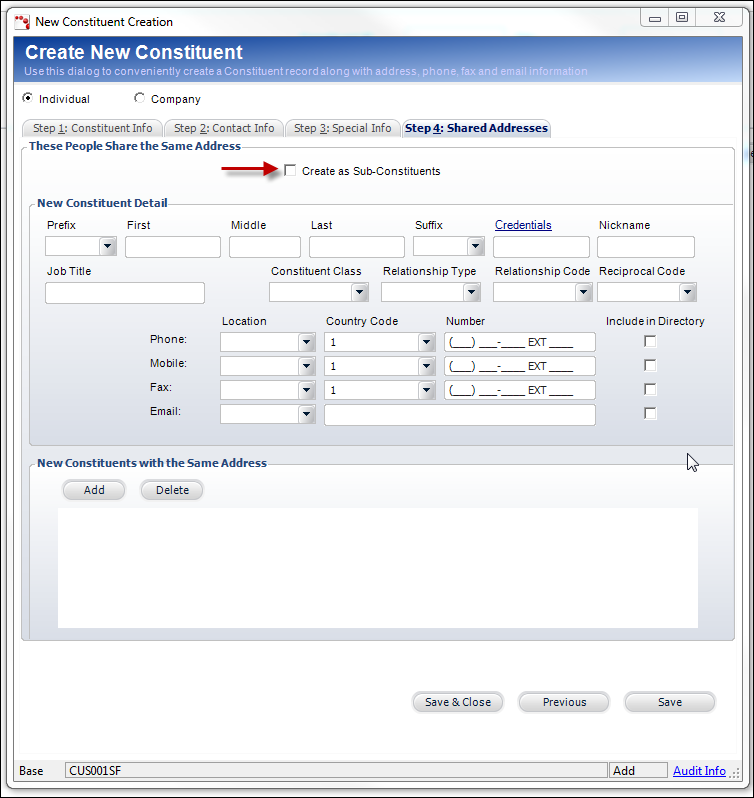
42. On the Shared Addresses tab, select whether you want to Create as Sub-Constituent, red arrow in image above.
43. Enter the new constituent's detail information and click Add.
44. As of 7.4.0SP1,
if the REQ_USE_OF_CONSTITUENT_ROLES
application parameter is set to "Y", the Step 5: Constituent
Roles tab displays, as shown below. If not, click
Save & Close to save the new constituent.
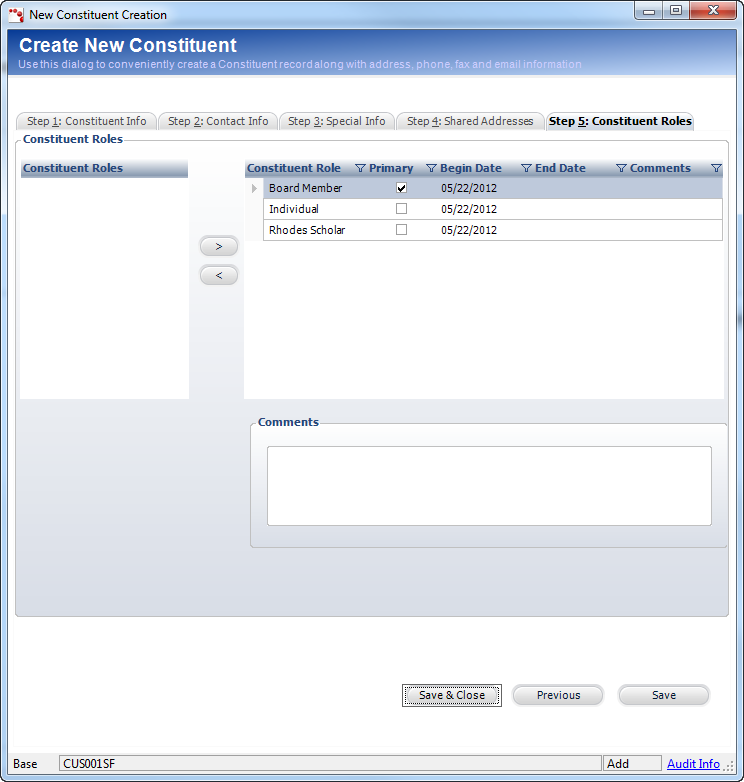
45. Highlight the role code in the Constituent Roles box that you want to assign.
46. Click the right arrow (>) to add the code.
47. Select the End Date in which the role no longer applies.
48. Enter any Comments about the assignment or ending role.
49. Click Save & Close.